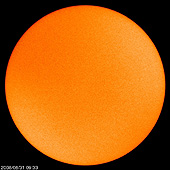DailyTech | Michael Asher | Sept. 1, 2008

The sun has reached a milestone not seen for nearly 100 years: an entire month has passed without a single visible sunspot being noted.
The event is significant as many climatologists now believe solar magnetic activity – which determines the number of sunspots — is an influencing factor for climate on earth.
According to data from Mount Wilson Observatory, UCLA, more than an entire month has passed without a spot. The last time such an event occurred was June of 1913. Sunspot data has been collected since 1749.
When the sun is active, it’s not uncommon to see sunspot numbers of 100 or more in a single month. Every 11 years, activity slows, and numbers briefly drop to near-zero. Normally sunspots return very quickly, as a new cycle begins.
But this year — which corresponds to the start of Solar Cycle 24 — has been extraordinarily long and quiet, with the first seven months averaging a sunspot number of only 3. August followed with none at all. The astonishing rapid drop of the past year has defied predictions, and caught nearly all astronomers by surprise.
In 2005, a pair of astronomers from the National Solar Observatory (NSO) in Tucson attempted to publish a paper in the journal Science. The pair looked at minute spectroscopic and magnetic changes in the sun. By extrapolating forward, they reached the startling result that, within 10 years, sunspots would vanish entirely. At the time, the sun was very active. Most of their peers laughed at what they considered an unsubstantiated conclusion.
The journal ultimately rejected the paper as being too controversial.
The paper’s lead author, William Livingston, tells DailyTech that, while the refusal may have been justified at the time, recent data fits his theory well. He says he will be “secretly pleased” if his predictions come to pass.
But will the rest of us? In the past 1000 years, three previous such events — the Dalton, Maunder, and Spörer Minimums, have all led to rapid cooling. On was large enough to be called a “mini ice age”. For a society dependent on agriculture, cold is more damaging than heat. The growing season shortens, yields drop, and the occurrence of crop-destroying frosts increases.
Meteorologist Anthony Watts, who runs a climate data auditing site, tells DailyTech the sunspot numbers are another indication the “sun’s dynamo” is idling. According to Watts, the effect of sunspots on TSI (total solar irradiance) is negligible, but the reduction in the solar magnetosphere affects cloud formation here on Earth, which in turn modulates climate.
This theory was originally proposed by physicist Henrik Svensmark, who has published a number of scientific papers on the subject. Last year Svensmark’s “SKY” experiment claimed to have proven that galactic cosmic rays — which the sun’s magnetic field partially shields the Earth from — increase the formation of molecular clusters that promote cloud growth. Svensmark, who recently published a book on the theory, says the relationship is a larger factor in climate change than greenhouse gases.
. . . more



